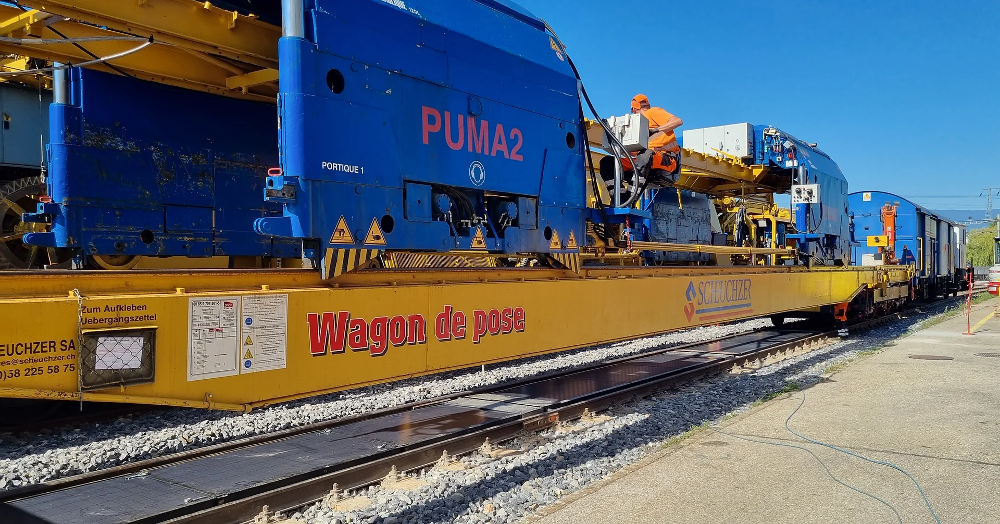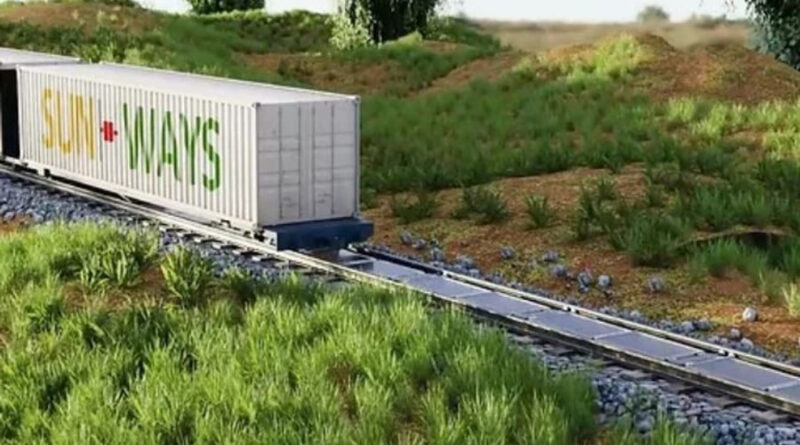Swiss Experiment Will Place Solar Panels Between Train Tracks
Enough sunlight falls on the Earth every day to meet the energy needs of every human being for a year. Sunlight is free, so in theory, we could harvest it and have unlimited electrical energy for every purpose — making green steel and cement, powering mines, operating factories, recharging the batteries in electric vehicles — even meeting the voracious needs of data centers — for free. There are some obstacles to that utopian vision. Some people would rather die from extreme heat than be forced to look at solar panels. There also needs to be a grid system that can collect all that free solar energy and distribute it to where it is needed. Grid infrastructure such as transmission lines and substations are not free, and so the notion of abundant electrical energy at little to no cost is a pleasant fantasy but not very realistic.
People have some great ideas for places where solar panels can be mounted where they won’t ruin the view. There are tens of thousands of acres of roofs on large commercial buildings and factories available. Solar canopies over parking lots could add many thousands more acres of solar panels. There are hundreds of thousands of miles of highway dividers and thousands of acres at highway interchanges that could serve as areas to mount solar panels. Covering irrigation canals, lakes, and even parts of the ocean with panels is also under consideration.
The Swiss are known for being clever engineers. One of them, Baptiste Danichert, is the co-founder of Sun-Ways, a startup that proposes to put the space between railroad tracks to good use by installing solar panels between the rails. The panels will be removable so railroads can do repairs to the tracks as needed. “There are over a million kilometers of railway lines in the world,” Danichert said last year. “We believe that 50 percent of the world’s railways could be equipped with our system.”
On its website, Sun-Ways says, “Thanks to its patented technology, our system integrates renewable energy production into railway infrastructures. Due to its flexibility and adaptability, our device makes it possible to easily install and remove all or part of a solar power plant placed between the rails of a railway track. Ultimately, our solution will be able to take advantage of the current development of power electronics in the field of linear photovoltaics.
“Integrating photovoltaics into the railway sector is not easy, as the sector is highly regulated. However, a pragmatic technical development strategy based on taking into account the constraints related to railway maintenance and operation from the outset has allowed us to arrive at a technology that meets these expectations. We are therefore working closely with industry players to align our technology with the most demanding infrastructure standards and safety regulations.”
Removable Solar Panels

Sun-Ways has patented its removable system for solar panels and is about to begin testing the technology in collaboration with EPFL, the Swiss federal technology institute based in Lausanne. A three-year-long trial phase is scheduled to begin in the spring of 2025 in the western canton of Neuchâtel. “This will be the first time that solar panels will be installed on a railway track with trains that pass over them,” Sun-Ways CEO Joseph Scuderi said.
To make the process work, Sun-Ways has created a specialized train in conjunction with Swiss railroad track maintenance company Scheuchzer. The train is equipped with a piston mechanism that unfolds the one-meter-wide pre-assembled panels, which are manufactured in a Swiss factory. The equipment is capable of installing up to 1,000 square meters of panels per day. The initial phase will involve fitting 48 panels along a 100-meter-long section of track managed by transN, the canton’s public transportation company, at a cost of about €623,000. Any electricity generated from these panels will be fed into the local power grid and used to provide residential electricity. Using it to power railway operations would require a more complex integration process.
We know what you are thinking. €623,000 seems like a lot of money for 100 meters of solar panels, and you are right. But bear in mind this is new technology. 30 years ago, solar panels were so expensive, most people thought they would have no practical uses other than powering research stations in Antarctica. Yet, today, they provide the least expensive source of electricity known to humanity, so let’s give Sun-Ways a little breathing room to try this and figure out if it can be done profitably or is just another pie in the sky boondoggle. At this point, it is impossible to say which outcome is more likely.
The journey to making this innovative project a reality has not been without its hurdles, the company says. Initially, the Federal Office of Transport had reservations, leading to a temporary rejection. However, after 10 months committed to building and testing prototypes, Sun-Ways successfully secured the requisite permits to proceed. The International Union of Railways also raised concerns. It worried that the panels may be prone to micro-cracks which could increase the risk of fires.
There were also concerns that glare and reflections from the panels might distract train drivers. Sun-Ways has responded to those challenges by reinforcing the durability of their panels and implementing an anti-reflection filter to avoid impairing train drivers’ vision. In addition, Sun-Ways promises that integrated sensors will monitor the panels’ performance rigorously. To maintain the panels’ effectiveness, brushes attached to the end of trains will clear off any accumulating dirt.
Praise For Sun-Ways
Lubomila Jordanova, CEO and founder of Plan A and co-founder of Greentech Alliance, told Energy Digital Magazine that there is a bright future for Sun-Ways if the initial experiment is completed successfully. Deploying the system across Switzerland’s 5,317 kilometer railway network would blanket an area equivalent to 760 football fields in photovoltaic cells. Annually, that could yield approximately 1 TWh of solar energy, enough to meet about 2 percent of Switzerland’s total energy consumption. The company is now contemplating expanding into Spain, Romania, and South Korea.
On LinkedIn, Jordanova said, “This system uses the vast network of underutilized railway tracks for solar energy generation, creating a highly scalable, efficient, and environmentally friendly way to produce clean power. A key advantage of this innovation is that it capitalizes on existing infrastructure, eliminating the need for acquiring additional land for solar farms. Europe alone has over 200,000 kilometers of railway tracks, representing a significant opportunity for energy production. If just 10 percent of these tracks were equipped with solar panels, it could generate enough electricity to power approximately 300,000 homes annually. Using existing railway tracks minimizes the environmental impact compared to building new solar farms on undeveloped land. This aligns with growing global priorities for reducing the environmental footprint of energy projects and meeting carbon reduction targets.”
Jordanova is correct, of course, assuming the Sun-Ways trial goes well. It is an interesting way of taking empty space that has no other purpose and making it productive. Humanity will need such creativity if we are to address the gathering climate crisis. As we get updates about this new technology, we will share them with you.
Have a tip for CleanTechnica? Want to advertise? Want to suggest a guest for our CleanTech Talk podcast? Contact us here.
Sign up for our daily newsletter for 15 new cleantech stories a day. Or sign up for our weekly one if daily is too frequent.
CleanTechnica uses affiliate links. See our policy here.
CleanTechnica's Comment Policy

